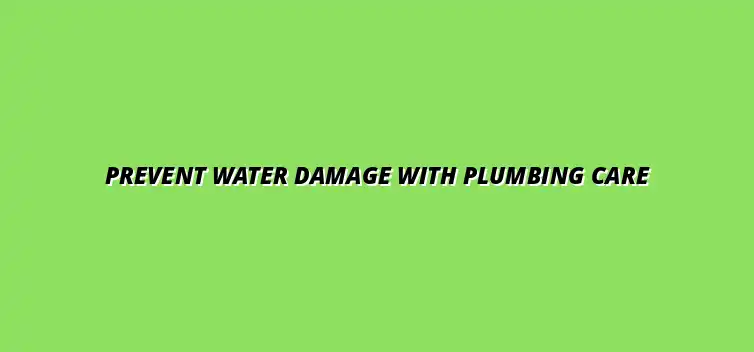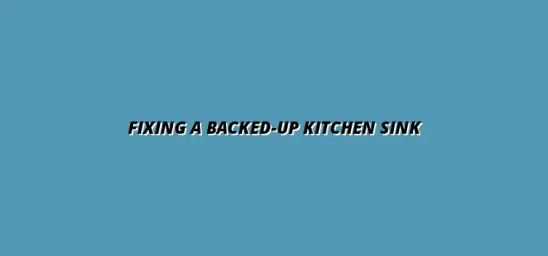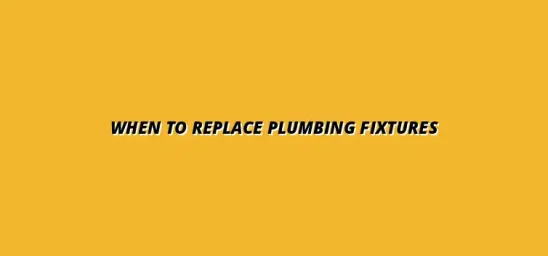
Prevent Water Damage with Plumbing Care
Understanding the Importance of Plumbing Upkeep in Preventing Water Damage
When it comes to home maintenance, keeping an eye on your plumbing is essential. Proper plumbing upkeep not only ensures that your water supply is safe and reliable but also plays a critical role in preventing water damage. Water damage can lead to costly repairs, mold growth, and a drop in your property's value, making it necessary to prioritize plumbing maintenance.
Additionally, the consequences of neglecting plumbing systems can be extensive. A sudden leak or broken pipe can cause significant structural damage before you even realize there's a problem. By understanding the risks associated with poor plumbing maintenance, homeowners can take proactive steps to protect their properties. For example, learning how to unclog your drain without calling a plumber can prevent minor issues from becoming major headaches.
The Financial and Structural Risks of Water Damage
Water damage can create serious financial burdens for homeowners. Repairs can easily run into thousands of dollars, covering everything from water extraction to structural repairs. Moreover, the cost of insurance premiums may increase if a home has a history of water-related claims, making it even more critical to prevent these issues.
On the structural side, water damage can weaken foundations, walls, and ceilings. Rotting wood, compromised insulation, and rusting metal components contribute to a declining structural integrity. Understanding these risks can help in making informed decisions about routine plumbing maintenance. Preventing pipe corrosion at home is a key aspect of this.
Impact of Water Damage on Property Value
Water damage doesn't just come with repair costs; it can significantly reduce your property's value. When potential buyers see signs of past water damage, they may assume there are ongoing issues, making them hesitant to purchase. A home with a damaged reputation may linger on the market for longer periods, costing you both time and money.
Furthermore, the presence of mold, which often accompanies water damage, can lead to legal issues if not properly addressed. Ensuring your plumbing is well-maintained can help preserve your home’s value and attractiveness to buyers. Regular drain cleaning is a simple yet highly effective preventative measure.
Long-Term Effects on Home Structure
Ignoring plumbing upkeep can lead to long-term issues that aren't immediately visible. For example, consistent leaks can lead to dry rot in wooden structures, resulting in costly repairs. Additionally, ongoing moisture can create environments conducive to mold growth, posing health risks to your family.
Over time, these structural damages may compromise the safety and livability of your home. That’s why regular plumbing maintenance plays a crucial role in maintaining the overall integrity of your home. Simple steps like following winter plumbing tips for frozen pipes can make a big difference.
Essential Plumbing Maintenance Practices for Water Damage Prevention
To avoid the risks associated with water damage, implementing essential plumbing maintenance practices is key. Regular inspections and upkeep can help identify potential issues before they develop into costly repairs. By taking a proactive approach, homeowners can enjoy peace of mind and a safer living environment.
Here are some practices every homeowner should consider adopting:
- Schedule routine inspections of all plumbing systems.
- Ensure water pressure remains within normal ranges.
- Maintain drainage systems to avoid clogs and backups.
Regular Inspection of Pipes and Fittings
One of the best ways to prevent water damage is through regular inspections of pipes and fittings. Look for visible signs of wear and tear, such as rust or corrosion, and pay attention to any damp spots on your walls or ceilings. Early detection can save you from larger issues down the line!
It's also wise to keep an eye on areas where pipes join or bend, as these spots can be prone to leaks. Having a checklist for inspections can make this process easier and more thorough. Regular cleaning can improve your plumbing efficiency.
- Check for visible leaks or stains on walls and ceilings.
- Inspect joints and fittings for signs of rust.
- Assess the condition of exposed pipes in basements and crawl spaces.
Identifying Signs of Wear and Tear
Being vigilant about wear and tear is crucial in plumbing maintenance. Look for signs like dripping faucets, low water pressure, and unusual noises from pipes. These issues can indicate deeper problems that may need immediate attention.
Moreover, understanding the typical lifespan of various plumbing materials can help you plan for replacements before failures occur. For instance, copper pipes often last 50 years, while PVC pipes may only last 20-30 years.
When to Call a Professional for Pipe Inspection
While DIY inspections are helpful, certain situations warrant a professional's expertise. If you notice recurring leaks, persistent low water pressure, or signs of water damage in hard-to-reach areas, it’s time to call in a professional. Their experience can help identify issues that may not be immediately visible to the untrained eye. If you need a plumber in Birmingham, consider checking out this local plumber.
Also, if your plumbing system is older, consider scheduling regular professional inspections as a preventive measure. This can help catch potential problems early, saving you time and money in the future.
Maintaining Your Home’s Water Pressure
Keeping your home's water pressure at the correct level is crucial for plumbing health. Normal water pressure usually ranges from 40 to 60 psi. Anything above that can stress your pipes and fittings, leading to leaks or bursts over time.
Monitoring your water pressure can be as simple as using a pressure gauge. If you notice fluctuations or consistently high pressure, it may be time to adjust your pressure regulator or consult a professional.
Understanding Normal Water Pressure Levels
Normal water pressure levels are essential for optimal plumbing performance. If you’re unsure about your home's water pressure, you can easily test it with a gauge attached to an outdoor faucet. Regularly monitoring these levels helps you catch any anomalies early!
Maintaining the right pressure not only protects your plumbing but also enhances water flow, making everyday tasks easier.
How High Water Pressure Can Cause Damage
High water pressure can have devastating effects on your plumbing system. It may lead to frequent leaks, burst pipes, and increased wear on your appliances, such as dishwashers and washing machines. As a result, ensuring your water pressure remains within normal ranges can save you from costly repairs.
Anytime your water pressure exceeds 60 psi, it’s wise to consider adjustments. Installing a pressure regulator can help manage fluctuations and maintain safe levels. Understanding the basics of winter plumbing is also essential for preventing damage.
Proper Drainage System Maintenance
A well-maintained drainage system is vital for preventing water damage. Blocked gutters and downspouts can cause water to overflow, potentially seeping into your home's foundation. Regularly cleaning these systems can go a long way in protecting your property.
Proper drainage maintenance includes not only cleaning but also ensuring that your gutters and downspouts direct water away from your home. A few simple adjustments can make a significant difference!
Cleaning Gutters and Downspouts
Cleaning your gutters and downspouts at least twice a year is a simple task that yields great benefits. Debris buildup can lead to clogs, causing water to spill over and accumulate around your home. This can ultimately lead to foundation issues or basement flooding!
Always use proper safety equipment and, when necessary, consider hiring professionals to handle this task. It’s essential to ensure your drainage systems are functioning efficiently.
Ensuring Proper Slope and Water Flow
For drainage systems to work effectively, they need the proper slope. Ideally, gutters should slope slightly towards downspouts to facilitate water flow. If you notice standing water in your gutters, you may need to adjust the pitch!
Additionally, ensuring your landscaping directs water away from your home can help prevent water pooling near the foundation. A few strategic changes can protect your home from water damage!
Addressing Frequently Asked Questions About Plumbing Maintenance
Many homeowners have questions about plumbing maintenance and its role in preventing water damage. Understanding the right practices can save you time, money, and major headaches down the line. Let’s dive into some common inquiries and ensure you’re well-informed!
How Often Should I Inspect My Plumbing System?
It’s essential to know the frequency of plumbing inspections to keep everything in tip-top shape. Generally, I recommend checking your plumbing system at least once a year. However, if you notice any unusual signs, more frequent inspections may be necessary.
- Inspect every six months if you own an older home.
- Check quarterly if you live in an area with extreme temperatures.
- Schedule immediate inspections if you notice leaks or water stains.
Best Practices for Scheduling Inspections
To keep things organized, you can create a simple schedule for inspections. I find that setting reminders on your phone or marking it on your calendar is a great way to remember. Here are some best practices:
- Choose a specific month for annual checks, such as before winter.
- Document any issues and repairs to track progress.
- Involve your family in the process to raise awareness.
Signs That Indicate Immediate Attention is Required
Sometimes, your plumbing system will give off signals that it needs immediate attention. Being able to recognize these signs can save you from costly repairs. Look out for:
- Unexplained water stains on walls or ceilings.
- Increased water bills without a change in usage.
- Musty odors that indicate hidden leaks.
What to Do During a Plumbing Emergency
Plumbing emergencies can be stressful, but knowing what to do can make a difference. First, try to stay calm and assess the situation. Often, swift actions can minimize water damage significantly.
Immediate Steps to Minimize Water Damage
If you find yourself in a plumbing crisis, follow these steps:
- Shut off the main water supply to stop the flow.
- Clear the area of furniture and valuables to prevent damage.
- Use towels or buckets to catch dripping water.
When to Contact a Plumber
Understanding when to call in a professional is key. If you’re unable to resolve the issue on your own or feel overwhelmed, get help. Here are some situations to consider:
- If the leak is extensive or you can’t find the source.
- When sewage backups occur.
- If you notice severe pipe damage or corrosion.
Implementing a Long-Term Plumbing Maintenance Plan
Creating a long-term maintenance plan for your plumbing can help you avoid emergencies and ensure everything runs smoothly. By having a structured approach, you can feel more in control of your home’s plumbing.
Creating a Schedule for Routine Checks
Having a plan in place makes it easier to stay on top of your plumbing maintenance. Here’s how to develop a schedule for routine checks:
- Set regular intervals for inspections — monthly and yearly.
- Incorporate checks for visual signs of wear and tear.
- Include seasonal maintenance tasks based on your local climate.
Monthly Checklists for Homeowners
To simplify monthly checks, I recommend using a checklist. Here are some important items to include:
- Inspect exposed pipes for leaks or damage.
- Check for any damp spots on walls or ceilings.
- Test all faucets and showerheads for proper function.
Yearly Deep Maintenance Tasks
Yearly tasks require a bit more attention but are crucial for long-term health. Here’s what to consider:
- Flush your water heater to remove sediment buildup.
- Inspect your sump pump (if you have one) for proper operation.
- Check for proper insulation in areas prone to freezing.
The Benefits of Professional Plumbing Services
While DIY maintenance is great, there are times when professional help is the best option. Knowing when to seek professional assistance can save you time and money.
When to Seek Professional Help
Consider bringing in a plumber during the following situations:
- If you’re uncertain about an issue or how to fix it.
- When you need repairs that require specialized tools.
- If you’re planning renovations that affect plumbing.
How Professionals Can Provide Peace of Mind
Hiring a professional can take the stress off your shoulders. They can offer expertise and experience that allows you to rest easy. Here are some benefits:
- Thorough inspections and diagnostics.
- Guaranteed workmanship and warranties.
- Knowledge of local codes and regulations.
Final Thoughts on Preventing Water Damage Through Plumbing Care
Taking care of your plumbing is an essential part of home ownership. Implementing the right practices can prevent major water damage and extend the life of your plumbing system.
Summary of Key Practices for Effective Preventive Measures
In summary, staying proactive about plumbing maintenance is crucial. Here are some key practices to keep in mind:
- Conduct regular inspections and maintenance checks.
- Know the signs that require immediate attention.
- Establish a long-term maintenance plan.
Reinforcing Regular Maintenance as a Habit
Regular maintenance should become a habit rather than a chore. By making it a part of your routine, you can better protect your home from unexpected issues. Trust me, your future self will thank you!
Encouragement to Stay Proactive in Plumbing Care
Staying proactive in plumbing care is your best line of defense against water damage. Empower yourself with knowledge, utilize available resources, and don’t hesitate to ask for help when needed. Your home is worth it!





Fixing a Backed-Up Kitchen Sink
Prepare Your Plumbing for Weather
Installing a Kitchen Sink Drain
When to Replace Plumbing Fixtures
Fixing a Jammed Garbage Disposal